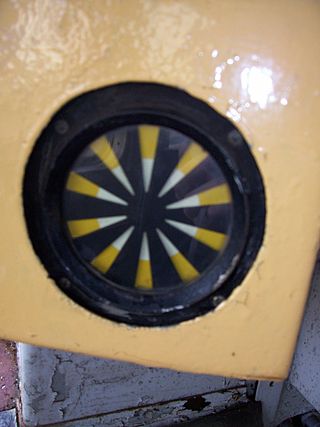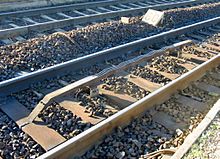
A railway signal is a visual display device that conveys instructions or provides warning of instructions regarding the driver’s authority to proceed. The driver interprets the signal's indication and acts accordingly. Typically, a signal might inform the driver of the speed at which the train may safely proceed or it may instruct the driver to stop.

Railway signalling (BE), also called railroad signaling (AE), is a system used to control the movement of railway traffic. Trains move on fixed rails, making them uniquely susceptible to collision. This susceptibility is exacerbated by the enormous weight and inertia of a train, which makes it difficult to quickly stop when encountering an obstacle. In the UK, the Regulation of Railways Act 1889 introduced a series of requirements on matters such as the implementation of interlocked block signalling and other safety measures as a direct result of the Armagh rail disaster in that year.
The Train Protection & Warning System (TPWS) is a train protection system used throughout the British passenger main-line railway network, and in Victoria, Australia.

A signal passed at danger (SPAD), known in the United States as a stop signal overrun (SSO) and in Canada as passing a stop signal, is an event on a railway where a train passes a stop signal without authority. This is also known as running a red.

Automatic Warning System (AWS) is a railway safety system used in railways around the world. It provides a train driver with an audible indication of whether the next signal they are approaching is clear or at caution. Depending on the upcoming signal state, the AWS will either produce a 'horn' sound, or a 'bell' sound. If the train driver fails to acknowledge a warning indication, an emergency brake application is initiated by the AWS. However if the driver correctly acknowledges the warning indication by pressing an acknowledgement button, then a visual 'sunflower' is displayed to the driver, as a reminder of the warning.

Cab signaling is a railway safety system that communicates track status and condition information to the cab, crew compartment or driver's compartment of a locomotive, railcar or multiple unit. The information is continually updated giving an easy to read display to the train driver or engine driver.

Automatische TreinBeïnvloeding or ATB is a Dutch train protection system first developed in the 1950s. Its installation was spurred by the Harmelen train disaster of 1962.

Automatic train control (ATC) is a general class of train protection systems for railways that involves a speed control mechanism in response to external inputs. For example, a system could effect an emergency brake application if the driver does not react to a signal at danger. ATC systems tend to integrate various cab signalling technologies and they use more granular deceleration patterns in lieu of the rigid stops encountered with the older automatic train stop (ATS) technology. ATC can also be used with automatic train operation (ATO) and is usually considered to be the safety-critical part of a railway system.

PZB or Indusi is an intermittent cab signalling system and train protection system used in Germany, Austria, Slovenia, Croatia, Romania, Israel, Serbia, on two lines in Hungary, on the Tyne and Wear Metro in the United Kingdom, and formerly on the Trillium Line in Canada.

The railway signalling system used across the majority of the United Kingdom rail network uses lineside signals to control the movement and speed of trains.
The Ais Gill rail accident occurred on the Settle–Carlisle line in Northwest England on 2 September 1913. Two long trains were both ascending a steep gradient with some difficulty, because their engines generated barely enough power to carry the load. When the first train stopped to build up steam pressure, the driver and fireman of the second train were distracted by maintenance routines, and failed to observe the warning signals. The collision wrecked several carriages, which were then engulfed by flammable gas, killing 16 people and injuring 38.
A train protection system is a railway technical installation to ensure safe operation in the event of human error.

The Spa Road Junction rail crash was an accident on the British railway system which occurred during the peak evening rush hour of 8 January 1999 at Spa Road Junction in Bermondsey, in South East London.

Japanese railway signals, according to the ministerial decree defining technical standards of railways, are defined as indicating operational conditions for railway staff driving trains.
Swiss railway signalling describes the railway signalling systems used in Switzerland by the different railway companies. There are two main types of signal, used up to 160 km/h, above which speed cab signalling is required.
Belgian railway signalling is the signalling in effect on the Belgian rail network currently operated by Infrabel.

The application of railway signals on a rail layout is determined by various factors, principally the location of points of potential conflict, as well as the speed and frequency of trains and the movements they require to make.

LS is a cab signalling and train protection system used on the main lines of Czech and Slovak railways. This system continuously transmits and shows a signal aspect of the next main signal in the driver's cabin while also periodically checking the driver's vigilance when their attention is required.
The intermittent inductive automatic train stop is a train protection system used in North American mainline railroad and rapid transit systems. It makes use of magnetic reluctance to trigger a passing train to take some sort of action. The system was developed in the 1920s by the General Railway Signal Company as an improvement on existing mechanical train stop systems and saw limited adoption before being overtaken by more advanced cab signaling and automatic train control systems. The system remains in use after having been introduced in the 1920s.

On the evening of 26 December 1962, cold weather and snow in and around Crewe had caused points to become frozen and trains were being detained at signals. About midway between Winsford and Crewe, the 13:30 Glasgow Central to London Euston Mid-Day Scot, hauled by an English Electric type 4 diesel, D215, with 13 coaches and 500 passengers, was stopped at a signal but the driver found the telephone to Coppenhall Junction, the next signal box ahead, out of order. Seeing the next signal ahead he decided to proceed down towards it and use the telephone there, but too fast. In the darkness he failed to notice the 16:45 express from Liverpool Lime Street to Birmingham New Street, hauled by an electric locomotive with eight coaches with 300 passengers, standing on the line ahead and collided with it at about 20 mph (32 km/h).














